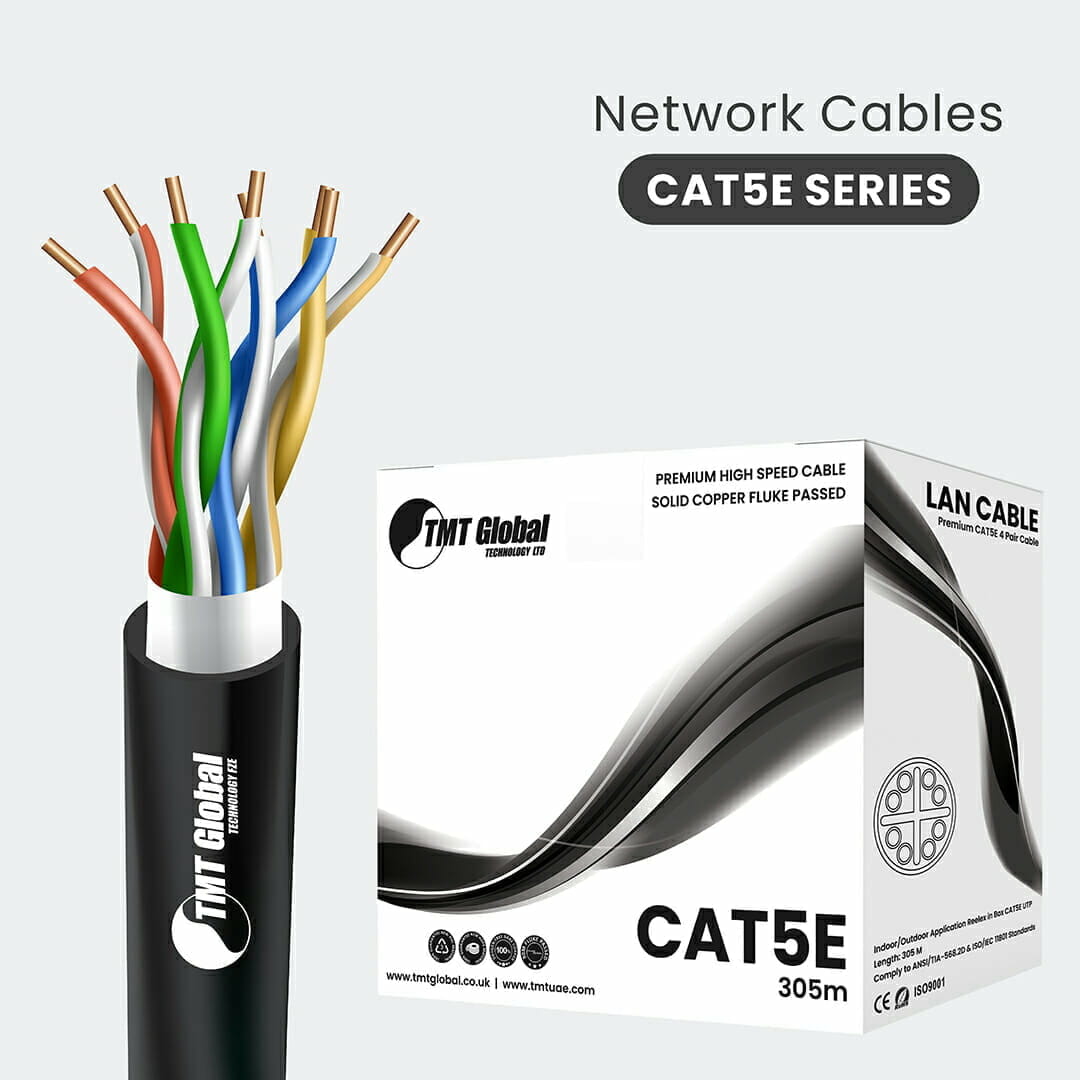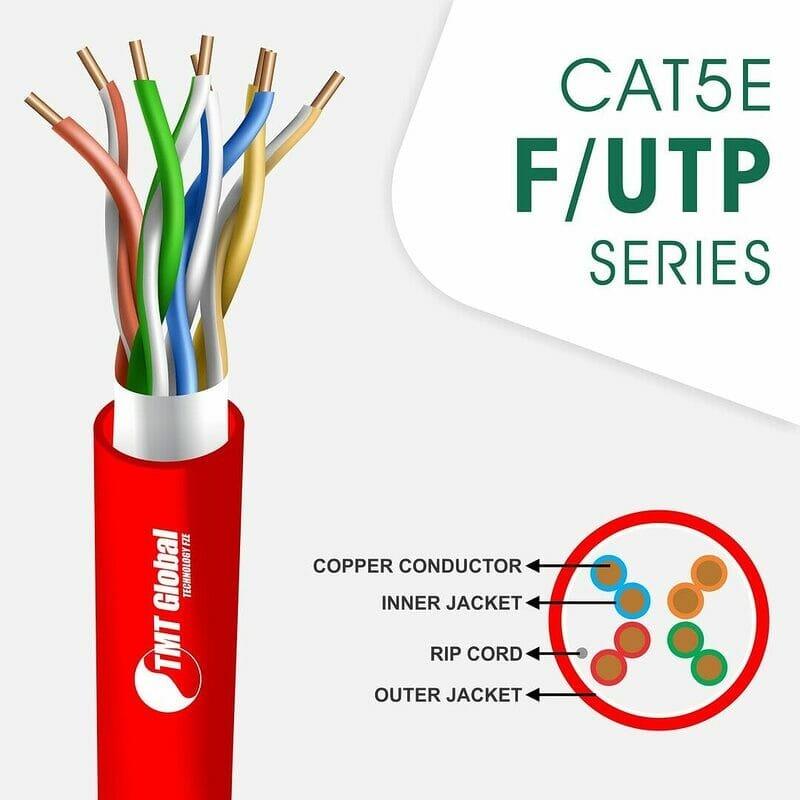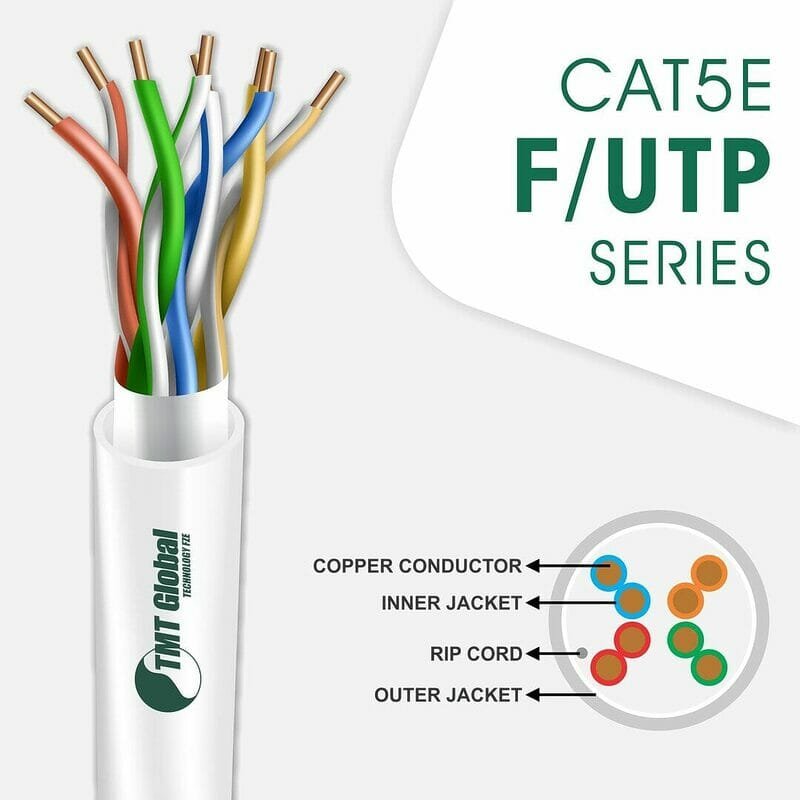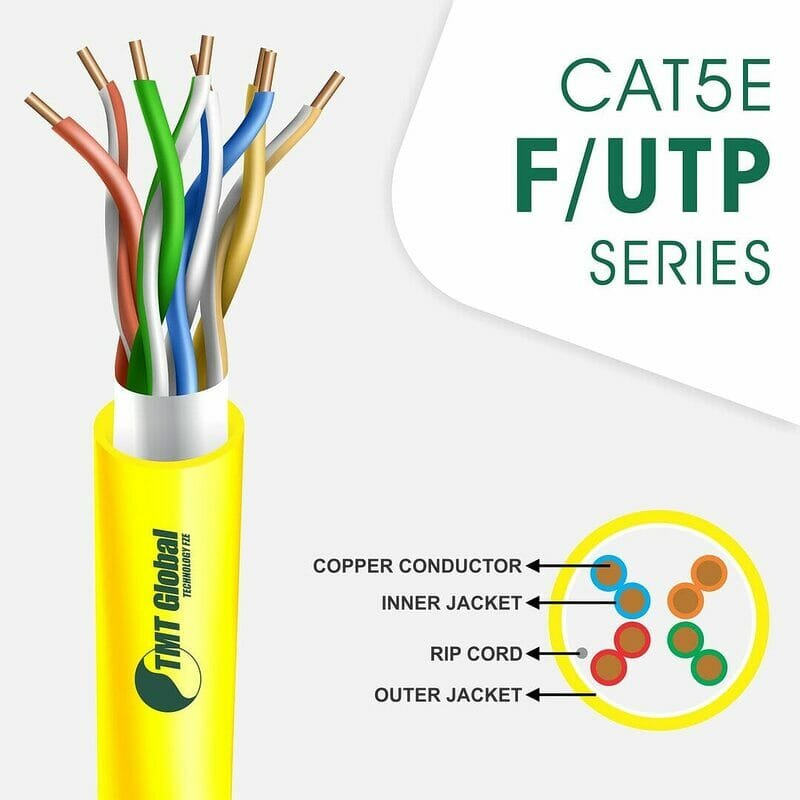Understanding CAT5e F/UTP Outdoor Network Cables by TMT Global Technology Ltd UK in oman

Introduction to CAT5e Cables
CAT5e cables, or Category 5 enhanced cables, are a type of twisted pair Ethernet cable designed for high-speed data transmission. As an advancement over the original CAT5 standard, these cables boast better performance and reduced crosstalk, making them suitable for a variety of networking applications. The most notable specification of CAT5e cables is their ability to support data rates of up to 1 Gbps (Gigabit per second) over distances of 100 meters, which is crucial for modern networking environments. CAT5e F/UTP Outdoor Network Cables
The structure of CAT5e cables includes four pairs of twisted copper wires, which helps minimize interference and ensures optimal signal quality. This configuration not only enhances the cable’s overall performance but also contributes to its flexibility and ease of installation. CAT5e cables are typically made with PVC or low-smoke materials, providing options for different environments and installation requirements.





One of the key differences between CAT5e and other categories, such as CAT6 and CAT6a, lies in their performance capabilities and applications. While CAT6 cables can handle speeds of up to 10 Gbps and greater transmission frequencies, CAT5e remains a popular choice for many residential and commercial installations due to its balancing capability. It is commonly used in Local Area Networks (LAN), VoIP systems, and video surveillance setups, where reliable connectivity is essential.
Despite the emergence of newer cable standards, CAT5e cables continue to maintain a strong presence in the networking landscape. Their affordability, sufficient bandwidth, and wide-ranging compatibility with various devices make them an attractive option for both home users and businesses alike. As technology continues to evolve, CAT5e cables may still provide the necessary infrastructure for many network environments that do not demand the higher speeds offered by their successors.
What is F/UTP?
F/UTP, or Foiled Unshielded Twisted Pair, is a type of cabling that incorporates a foil shield surrounding pairs of twisted conductors, aiming to minimize electromagnetic interference (EMI). The design features pairs of wires twisted together to reduce crosstalk and improve signal integrity. The foil shielding significantly contributes to reducing the impact of external noise, making it an ideal choice for outdoor network installations where exposure to potentially disruptive signals is a concern.
The construction of F/UTP cables differs from standard unshielded twisted pair (UTP) cables, which lack the additional foil layer. By adding this layer, F/UTP enhances performance in environments with high electromagnetic fields. This characteristic is particularly beneficial in settings where cables are routed through areas with other electronic devices, power lines, or industrial equipment that may emit interference.
Furthermore, F/UTP cabling is designed to maintain signal integrity over longer distances, which is typically required in outdoor applications. This enhanced capability stems from the reduced levels of interference, allowing for clearer, more reliable communication between devices. This aspect makes F/UTP an attractive option for organizations seeking high-performance networking solutions.
In terms of installation, F/UTP networks offer flexibility, allowing for the deployment of structured cabling systems that can accommodate future upgrades. The resistance to interference and the overall robustness of F/UTP ensure that the network performs consistently, even in adverse conditions often associated with outdoor installations.
Overall, F/UTP plays a crucial role in modern networking, particularly in outdoor environments where the potential for interference is heightened. It is an efficient solution for those seeking reliable, high-quality data transmission capabilities amidst complex external conditions.
The Benefits of Using Outdoor Network Cables
When it comes to establishing a reliable network infrastructure, particularly in outdoor settings, the choice of cables is paramount. Outdoor network cables, such as CAT5e F/UTP cables, are specifically designed to meet the challenges posed by environmental factors. One of the primary advantages of using outdoor-rated cables is their enhanced weather resistance. These cables are constructed with materials that can withstand rain, snow, and extreme temperatures, ensuring that the network remains functional regardless of the weather conditions.
UV protection is another significant benefit. Outdoor network cables are often sheathed with UV-resistant materials that prevent degradation due to prolonged exposure to sunlight. This is crucial since standard cables may deteriorate quickly when subjected to direct sunlight, leading to performance issues and potential network failures. By investing in UV-protected outdoor cables, users can prolong the lifespan of their network infrastructure, reducing the frequency of replacements and repairs.
Durability against various environmental factors also plays a crucial role in the effectiveness of outdoor network cables. These cables are designed to resist not only moisture and UV light but also other harmful elements such as chemical exposure and physical abrasion. This resilience makes them suitable for a variety of outdoor applications, including construction sites, industrial environments, and outdoor event setups. The ability to withstand harsh conditions ensures reliable network performance and minimizes downtime caused by cable damage.
In choosing the right outdoor-rated cable, users are not only safeguarding their investment but also enhancing the overall efficiency and reliability of their network. Therefore, the use of high-quality outdoor network cables is essential for ensuring optimal network performance in challenging environments.
TMT Global Technology Ltd’s Manufacturing Process
TMT Global Technology Ltd employs a meticulous manufacturing process for its CAT5e F/UTP outdoor network cables, ensuring that every product meets the highest standards of quality and reliability. The journey begins with the careful selection of materials. The company sources top-grade raw materials, including copper conductors and durable insulation, which are critical for maintaining the cable’s performance in outdoor conditions. By collaborating with reputable suppliers, TMT ensures that all materials used comply with both national and international standards.
Once the materials are sourced, the manufacturing process adheres to strict quality control measures at every stage. TMT Global Technology Ltd implements a series of inspections and tests to verify that each component of the CAT5e F/UTP outdoor cables meets established specifications. This includes checking the tensile strength of the materials, signal integrity, and resistance to environmental factors like moisture and UV exposure. Such rigorous testing guarantees that the final product can withstand various challenges while providing optimal network performance.
Additionally, TMT Global Technology Ltd is dedicated to following industry best practices throughout the production process. The manufacturing facilities are equipped with advanced technology and automated systems that enhance precision and efficiency. The company’s commitment to innovation not only improves production timelines but also minimizes the risk of error, resulting in a superior end product. Moreover, compliance with industry certifications, such as ISO 9001, underscores TMT’s dedication to continuous improvement and customer satisfaction.
In conclusion, TMT Global Technology Ltd’s manufacturing process for CAT5e F/UTP outdoor network cables exemplifies a harmonious blend of quality materials, stringent quality control measures, and adherence to industry standards. This commitment solidifies their reputation as a reliable provider of high-performance network solutions.
Applications of CAT5e F/UTP Outdoor Cables
The CAT5e F/UTP outdoor cable has gained significant traction across various industries due to its robustness and adaptability in different environments. In telecommunications, it is commonly employed to establish reliable connections between telecommunication towers and base stations, ensuring high-speed data transmission even in adverse weather conditions. This capability makes it ideal for supporting the expanding networks required for mobile data communication and internet services.
In industrial settings, CAT5e F/UTP outdoor cables are ideal for machine-to-machine (M2M) communications, which are essential for the automation of manufacturing processes. These cables can withstand electromagnetic interference and physical strain, making them suitable for use in factories where durability is crucial. Moreover, their ability to transmit data swiftly is essential for real-time monitoring and control applications, ensuring increased efficiency in operations.
Another emerging application lies in smart city projects, where connectivity plays a vital role in urban development. CAT5e F/UTP outdoor cables support various smart technologies, such as street lighting control systems, environmental monitoring sensors, and traffic management systems. By functioning as reliable backbone infrastructures, these cables help facilitate communication between devices, enabling efficient resource management and enhancing the quality of urban life. Their versatility is a key attribute, allowing them to be implemented for both temporary installations and long-term infrastructures.
Furthermore, the ability to resist moisture and UV exposure is particularly beneficial in outdoor installations, ensuring the longevity of the network connections in adverse environmental conditions. Overall, the CAT5e F/UTP outdoor cable exhibits a wide range of applications across telecommunications, industrial environments, and smart city initiatives, demonstrating its versatility and performance across diverse settings.
Installation Tips for CAT5e Outdoor Cables
Installing CAT5e F/UTP outdoor cables requires careful planning and execution to ensure optimal performance and longevity. One of the first considerations when installing these network cables is the trenching process, which is crucial for both the protection and functionality of the cables. It is essential to dig trenches that are deep enough to accommodate the cables while also adhering to local regulations regarding underground utilities. Typically, a trench depth of at least 12 inches is recommended to protect the cables from potential physical damage.
Once the trench is prepared, it is vital to provide adequate protection for the CAT5e cables from various forms of physical damage. The use of conduit or protective cabling sleeves can minimize the risk of abrasion and impact. Additionally, if the environment is prone to moisture, utilizing waterproof conduits will further safeguard the cables. It is also advisable to elevate the cable where possible, especially in areas that are prone to flooding or excess water accumulation.
Grounding is another critical aspect of the installation process for CAT5e outdoor cables. Correct grounding techniques help prevent electromagnetic interference and protect against surges caused by lightning or other electrical disruptions. Ensure that the grounding system is compliant with local electrical codes, which may require specific grounding rods or mechanisms to be implemented alongside the gate entry points of the installation.
Lastly, staying informed about local regulations regarding installation is essential. Compliance ensures not only the safety of the installation but also adherence to legal codes that govern outdoor cabling work. It is advisable to consult with local permitting authorities to confirm any specific requirements, helping to facilitate a smooth installation process.
Testing and Maintenance of Network Cables
Ensuring the reliability and performance of network infrastructure necessitates a rigorous approach to testing and maintenance of network cables, such as CAT5e F/UTP outdoor cables. These cables are widely used for both residential and commercial applications due to their capacity to support high-speed data transmission. Regular testing not only identifies potential issues but also helps in the proactive management of the network, thus preventing downtime and service interruptions.
Various testing methods are employed to assess network cables’ performance. One commonly used technique is the use of a cable tester. This device can check for faults such as cable breaks, shorts, and crosstalk. A continuity tester verifies the integrity of the cable, ensuring that signals can travel without disruption. For more comprehensive evaluation, advanced tools like Time Domain Reflectometers (TDRs) are used. TDRs assess cable length and pinpoint the location of faults accurately, which is essential for timely maintenance efforts.
In addition to testing, regular maintenance practices contribute significantly to the longevity and efficiency of network cables. It is advisable to inspect cables periodically for signs of wear, such as fraying, kinks, or exposure to harsh environmental conditions. Proper cable management can prevent physical damage and reduce the risk of signal interference. Ensuring that network cables are adequately secured and organized minimizes the potential for accidental disconnections or tangling, promoting an efficient network environment.
Common issues with network cables, such as poor connectivity or intermittent signals, can often be traced back to improper installation or environmental factors. Addressing these issues promptly through regular inspection and testing prevents more significant problems from emerging. By prioritizing the testing and maintenance of CAT5e F/UTP outdoor cables, organizations can ensure optimal performance and seamless data transmission over their networks.
Comparing CAT5e with Other Ethernet Cable Types
When considering network infrastructure, selecting the appropriate Ethernet cable is critical for optimal performance. The CAT5e F/UTP cable is one of the most commonly used options, but it is essential to compare it with other cable types such as CAT6 and CAT6a to understand their respective advantages and limitations. One of the defining characteristics of CAT5e cables is their ability to support speeds up to 1 Gbps and bandwidth capabilities of 100 MHz. This makes them suitable for many small to medium-sized businesses and residential applications.
In contrast, CAT6 cables offer considerably enhanced performance with speeds of up to 10 Gbps over shorter distances (up to 55 meters) and a bandwidth capacity of 250 MHz. This improved functionality can be advantageous for environments that demand higher data transfer rates and more robust performance, especially where multimedia applications and high-volume transactions are concerned. Additionally, CAT6 cables typically utilize a more advanced shielding method, which provides better resistance to crosstalk and interference, further enhancing their reliability.
Extending the comparison, CAT6a cables are an even more improved variant, supporting 10 Gbps speeds over longer distances, specifically up to 100 meters, and boasting a bandwidth of 500 MHz. This makes CAT6a a superior choice for extensive network infrastructures that require sustained high-speed connectivity over considerable distances. The thicker insulation and superior shielding in CAT6a cables again contribute to improved performance, particularly in environments with high-density cabling.
Ultimately, the choice between CAT5e, CAT6, and CAT6a should be guided by specific networking needs, distances involved, and bandwidth requirements. While CAT5e is adequate for many scenarios, those requiring greater performance may benefit from transitioning to CAT6 or CAT6a cables. Understanding these differences is vital for optimizing network design and capacities.
Conclusion
When considering outdoor networking solutions, TMT Global Technology Ltd’s CAT5e F/UTP outdoor cables stand out due to their unique blend of durability, reliability, and performance. Designed specifically for outdoor use, these cables offer advanced features such as enhanced shielding, which is crucial in minimizing electromagnetic interference. This characteristic ensures a stable and consistent data transmission, making TMT’s product a favorable option for both residential as well as commercial applications.
Moreover, TMT Global Technology Ltd emphasizes quality by utilizing high-grade materials in their cables. This commitment to excellence results in products that not only meet but often exceed industry standards, thereby providing peace of mind for customers. The robustness of the cables ensures they withstand harsh weather conditions, including heavy rain, sunlight, and temperature fluctuations, which are common challenges for outdoor cabling installations.
In addition to durability, the installation process for TMT’s CAT5e outdoor cables is designed to be straightforward, facilitating timely project completion. Their flexible design and compatibility with various connectors mean that they can seamlessly integrate into existing networking setups, allowing for enhanced scalability as needs evolve.
By choosing TMT Global Technology Ltd’s CAT5e F/UTP outdoor cables, customers are not just purchasing a product; they are investing in a reliable networking foundation that can support current and future needs. The combination of performance, durability, and ease of installation positions these cables as an optimal choice for anyone seeking trustworthy networking solutions. For your next outdoor project, consider the advantages of TMT’s CAT5e cables to ensure efficient connectivity and durability.

